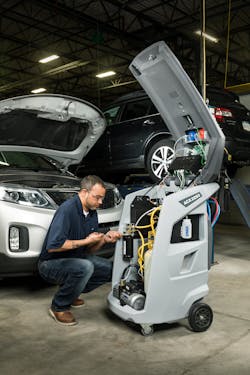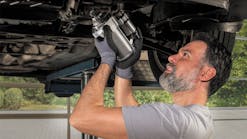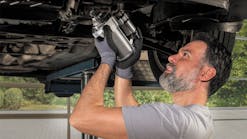Shop purchases and service procedure tune-ups are typically dictated by the vehicles coming through the door. Vehicles rolling into service bays today are changing how A/C service will be performed, thanks in no small part to synthetic R-1234yf refrigerant. R-1234yf refrigerant was codeveloped by DuPont and Honeywell as a successor to R-134a, and has an ultra-low Global Warming Potential (GWP). While R-134a generally has a GWP rating of 1,400 or greater, R-1234yf clocks in at less than 4.
“In 2021, federal standards will change and will require manufacturers to use a refrigerant with a GWP rating of 150 or less, says Chuck Kinkade, customer experience and product manager lead at MAHLE Service Solutions. “With carbon dioxide having a GWP of 1 [and R-1234yf in the low single-digits], you can see it’s a dramatic improvement for greenhouse gasses and the environment.”
Chuck Abbott, vice president of automotive sales at CPS Products, adds that passenger cars and light truck OEMs are moving all production to R-1234yf and are on track to have all vehicles using the gas by 2021.
Because working A/C is as ubiquitous for drivers today as power windows, A/C issues are not easily ignored … and technicians will likely need to get up to speed (if they haven’t already) on the certifications, tools, and service considerations necessary with new systems.
A change in service requirements
As vehicles change, so must a shop’s essential gear. Product Manager Jeremy Hyde of Cornwell Tools notes the demand for R-1234yf service equipment is at an all-time high. He says in the last two years, he’s seen aftermarket demand for R-1234yf service equipment increase, even doubling in 2019. Hyde and manufacturers expect the demand to continue to grow in the coming years.
When it comes to R-1234yf, shop owners and technicians should first make sure they possess 609 certifications from the Mobile Air Conditioning Society (MACS). Even if they’re already certified, it may be time to brush up on some of the unique aspects of servicing new R-1234yf AC systems.
“With both high-voltage systems and R-1234yf, the service procedures are different than what technicians have been used to with R-134a,” says Tim Wagaman, senior product manager for Robinair. “While the recovery process is like that of R-134a, some systems will work dramatically different … This is important to know when diagnosing and repairing R-1234yf systems.”
The first difference to consider is timing. R-1234yf requires a lengthier service time. Where R-134a systems recover and recharge in roughly 25-30 minutes, R-1234yf systems can take up to 45-50 minutes. This is because SAE requirements state that the machine must take extra steps when charging to help check for leaks and sample refrigerant to ensure it’s good, as well as to recover as much refrigerant as possible to prevent venting to the atmosphere.
Service procedures now require refrigerant identification and leak testing prior to charging.
“As R-1234yf is not compatible with PAG oils used in R-134a systems, technicians must identify and use the proper oils during service,” adds CPS’s Abbott.
Another big difference between R-134a and R-1234yf is the latter’s A2L flammability rating. R-1234yf is mildly flammable. This impacts workplace safety considerations, and new SAE standards apply to equipment used to service R-1234yf systems (for example, switches must be spark-free).
When one considers the increased amount of service time required, coupled with a more thorough job completed, cost becomes a unique consideration. Abbott says service providers should keep this in mind and charge accordingly.
“Service procedures [take longer] – charge accordingly,” Abbott says. “R-1234yf is expensive – charge accordingly. Be sure to use the proper A/C oil.”
Market trends
Not only are new-to-market A/C machines accommodating 1234yf, but they include new features to help make service streamlined and smart. Manufacturers are limited to what they can put on machines as they strive to meet SAE standards, so accessories can help enhance A/C service for both technicians and vehicle owners.
Built-in refrigerant identification is a significant feature of new A/C equipment, along with features like Wi-Fi and Bluetooth connectivity, as well as automatic software and system updates. Some machines on the market handle one type of refrigerant, while others can recover, recycle, and are certified to meet SAE J3030 for use on R-134a and R-1234yf systems. R-134a service equipment and system components are not interchangeable with R-1234yf systems unless they meet SAE standards. To prevent contamination, the two systems will have a different service port.
CPS’ Abbott says the FX3030 is the company’s leading dual-gas unit on the market. It is certified to SAE J3030 and can change from R-134a to R-1234yf in less than ten minutes. The company also offers a universal A/C oil that is compatible with R-1234yf and R-134a and is hybrid safe.
It’s up to a shop owner to decide if they want two dedicated units (one for R-134a and one for R-1234yf) or a unit that can handle both.
“There are a lot of things going on [in the industry],” says MAHLE’s Kinkade. “There are products [available] now, [which] you can attach to the system, [that will take] temperature and pressure readings to pinpoint diagnostics to see if you can find a component issue or a blockage for an evaporator; there are more tools available for that.”
Touchscreen interfaces are another new – and popular – feature. Screens can provide additional information while technicians perform the service.
[SS1] Robinair’s latest machines have a large, 10.5” touchscreen to display more information to technicians on the job. The 34998 is Robinair’s connected A/C machine for R-134a, while their AC1234-9 is the connected A/C machine for R-1234yf.
Many new A/C machines are Wi-Fi and Bluetooth capable, and include a speaker so technicians can watch and listen to training videos to help them better understand their new machine and service procedures.
“We’re at a tipping point where these vehicles that they’ve been producing with yf in the factory are starting to come out of warranty, and you’ll see these cars in more independent and secondary shops … and body shops as they get into A/C,” says Kinkade. That’s good to know for mobile tool distributors. “These machines have progressed from what was built 10 or 15 years ago. They were much faster without SAE requirements, but then you’ve got to remember maintenance was not as easy.”
As a mobile dealer, it’s important to know some of these distinctions, as even a seemingly small feature can give you the competitive edge.
“You may have a product with exclusive features; make sure you are talking about those to separate yourself from the competition,” says Cornwell’s Hyde.
Selling A/C from the truck
Alex Indeck is a Cornwell Tools dealer with a route located just south of Boston. Next April will be Indeck’s fourth year with the franchise. He stops everywhere from autobody shops to custom hot rod shops, transmission repair, dealerships, and smaller, independent repair places. At 26 years old, Indeck is quickly establishing himself as a powerhouse in sales; he is currently number one in sales company-wide. A part of that success includes keeping his customers stocked with the A/C tools and equipment they need.
“Believe it or not, I usually … pick up one or two A/C machines before summer and I try to keep them in stock,” Indeck says. “Towards the end of summer, I don’t usually have one.” He goes on to say most of the time A/C machines aren’t a planned-for purchase. “Ninety-nine percent of the time, unless shops have money to splurge, you get the call asking, ‘What do you have for an A/C machine? Mine just broke and I have a line of cars outside.”
A lot of his A/C machines go to mom and pop garages, custom shops, truck body companies, autobody companies doing collision work, and diesel shops. Indeck also keeps a few small, standalone carry units for on-the-road service work for machines and equipment.
“I try to push that stuff whenever I can, even when I’m just walking through a shop and I happen to see an older machine,” he says.
Indeck says many of his customers have questions on the A/C equipment needed to service today’s vehicles, so he tries to help them navigate the changes when he can.
“It depends on where you are,” Indeck says. “Some shops are certified and more knowledgeable [than others].”
He says oftentimes the small, independent places, or quick lubes, just want to know the simplest and easiest way to get it done. Cost is also a concern.
“A lot of my smaller shops are worried about the cost associated with R-1234yf, just because of how pricy it is,” Indeck says. “It’s very expensive compared with R-134a, and it will mean a big price difference where you get your car serviced – maybe $200 for R-134a [service] versus $700 for a R-1234yf service at an independent [repair place]. It's an extreme jump, and I think that jump is definitely going to scare some people.”
Beyond RRR
Mobile dealers would do well to consider additional A/C service items they can easily stock on the truck. Think: oil and dye injectors, valve core removers and installers, manifold gauge sets (compatible with both R-134a and R-1234yf refrigerants), and leak detectors compatible with new R-1234yf systems. UV lights also continue to evolve as they target UV wavelengths that react better with fluorescent dyes, making them brighter and better at pinpointing leaks.
“In yf and yf service, you do a 15 percent pre-charge prior to charging the vehicle, and then the units will ask you to do things like leak-checking and put a sniffer in the vent to check for leaks in the evaporator and things like this … [steps] that weren’t dictated by R-134yf standards,” Kinkade says.
These steps, which prolong the length of service, are among the biggest complaints with the new refrigerant. But each step is dictated by SAE standards, and the tools to complete them are available. Today’s tools are more accurate than ever, and with R-1234yf, technicians will want to recover as much as they can.
Indeck says he sells quite a few leak detectors – especially on the equipment side – and particularly to those working with extremely long line sets (for example, on a CAT excavator).
“You could be searching for a leak inside the cab and the coil and the rest of the A/C lines could be 10, 15 feet away in the back of the machine,” he says. “So, I’ve been selling a lot of leak detectors; all of them work well and I don’t have any complaints. A lot of it comes down to preference: some are pistol grips, straight, digital …. and some [technicians] prefer to stay away from the digital stuff.”
Robinair’s Wagaman agrees today’s leak detectors have gotten better over the years and can more accurately detect R-134a and R-1234yf.
“Older leak detectors may not detect R-1234yf at all, requiring shops to upgrade their equipment,” he says.
Mobile dealers can try to sell ancillary A/C products with the machine, keep them stocked on the truck in a dedicated section, or do both.
Learn it, tell it, then sell it
When navigating an A/C sale, it’s important to ask lots of questions. Try to understand a customer’s needs. Is the shop turning away R-1234yf vehicle service? How many vehicles per week are they servicing and what is their protocol?
“We’re seeing more vehicles each year using R-1234yf refrigerant as manufactures revamp their lineups, but R-134a will be around for many years,” Robinair’s Wagaman says.
In the next couple years, he says, shops will need to invest in several new pieces of equipment to service R-1234yf vehicles. This may include a machine meeting SAE J2843 standards, a leak detector that meets SAE J2913 and J2791 standards, a syringe-type oil injector (maybe two, if they see high-voltage and standard 12V compressors), and – optionally – a tracer gas leak detector if a technician wishes to use one.
As a Cornwell Tools dealer, Indeck says it’s important to be able to tell customers what they need to know. To do this, he relies on good sources to help him out with his own questions. Then, he makes sure to have the tools to show customers when they need it. A good place to start is talking with manufacturers and attending training at mobile shows or watching manufacturers’ videos that highlight what’s new.
“There are a million different ways to be a salesman,” Indeck says. “I am always bringing new stuff [into the shop]. I bring the stuff they need. The important thing, [whatever you’re selling], is to have it in stock, have information ready to show customers, and just be knowledgeable about what you’re showing the customer.”
Don’t stop at tote-and-promote tools; consider putting an A/C machine on the truck … just make sure it’s secured and protected from bumps in the road. MAHLE’s Kinkade recommends having a good scale that’s shock-protected – especially if there’s refrigerant in the tank – and then placing the unit on a foam pad on the floor to absorb shock.
“There are areas [on the truck] where you can fit a unit for demonstration. Having a unit with you is a nice way for people to take a look and experience it,” Kinkade says. “That goes a long way. Not everybody’s an A/C expert, and you have a different range of technicians and technician understanding.”
He says it’s also important to organize local training events, as these can naturally lead to sales.
When setting up for the sale, don’t forgot to consider timing. The best time to put an A/C machine on the truck is before the season starts.
A/C service is a very profitable business for most shops – especially in hotter months. Cornwell’s Hyde recommends mobile dealers start the conversation in the spring when summer is approaching.
“Shops should be well-versed in the new refrigerant by now and know that both R-1234yf and R-134a will be a large part of their A/C business for many years to come,” he says. “Making the investment in 1234yf service tools and equipment will no doubt pay off.”



